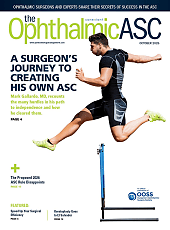This month in Retina Minute, I have the honor of speaking with Dr. Mohsin Ali from the Retina Group of Washington.
At ASRS in Long Beach, Dr. Ali, you presented an interesting paper about a nonsurgical potential treatment for floaters. Can you explain it for our audience?
Thank you, Dr. Singer. At the recent ASRS meeting, we shared the results of a study in which we investigated the use of low-dose 0.01% atropine eye drops to see if they could be a useful treatment for symptomatic vitreous floaters.
We all have patients in our retina clinics who find their floaters to be highly disruptive to daily activities, and historically we have advised patience for these individuals. In some instances, if they are bad enough for long enough, we might consider therapeutic options such as vitrectomy or YAG vitreolysis. But we know that those therapeutic options have the risk of potential vision-threatening complications.
Based on prior studies and patient reports, we also know that patients who have a change in their pupil diameter (ie, larger pupil diameters) might experience less visually symptomatic floaters, so extrapolating from our other in-clinic experience, we decided to test the theory of whether low-dose atropine might help.
What is the mechanism of why we think patients who are dilated notice their floaters less? Is there a physics or an optics understanding, or is it just anecdotal?
For me, it was driven by anecdotal experience, but there have been studies like Fourier optics models of the human eye that showed one influencing factor for the intensity of the floaters is a smaller pupil size. Other factors are, of course, the density of the floaters, the size of the opacities, and how far they are from the retinal plane, but of those particular factors, the one that is modifiable is the pupil diameter.
Tell us about your study.
We enrolled patients who had a history of symptomatic vitreous floaters—either vitreous syneresis without a posterior vitreous detachment (PVD)—or patients with a history of a PVD that was chronic for more than 3 months. Those who had an acute PVD within 3 months were excluded, along with individuals who had anatomically narrow angles as assessed by the Van Herick method or other significant media opacity such as vitreous hemorrhage, and individuals with preexisting vitreoretinal pathology like a retinal detachment or macular hole. We excluded individuals who previously had a pars plana vitrectomy.
In short, vitreous syneresis without a PVD or chronic PVD for at least 3 months were the inclusion criteria. Patients who met this criteria were prescribed low-dose atropine to be used once daily. They took a modified National Eye Institute visual function questionnaire before they began to use the eye drops and after using the drops daily for 1 week. We then looked at the number of patients who were satisfied with the drops and wanted to continue them because they were helping the floaters.
Overall, 44 patients were prescribed the low-dose atropine. Depending on how you splice the data, about 30% to 60% of them were satisfied with the drops and found symptomatic relief from the use of the low-dose atropine. We analyzed the data further to see if there was any impact on patients’ iris color, phakic status, or PVD status in terms of satisfaction rates, and we found no statistically significant difference there.
We also tried to determine the percentage of patients that had any adverse side effects such as worsened near vision, distance vision, or light sensitivity. About 4 patients or 18.2% had either near vision, distance vision, or light sensitivity issues, so it was quite well tolerated overall.
Historically, if you look at the low-dose atropine literature for myopia progression in children, no major vision-threatening side effects have been reported with the use of low-dose atropine, so it is also quite safe.
We concluded that low dose atropine can be an effective and noninvasive treatment option for individuals with persistently symptomatic vitreous floaters either from vitreous syneresis or PVD, but the efficacy is about 30% to 60%. In my anecdotal experience, having prescribed it to even more patients than that, the efficacy is probably closer to the 30% than it is to the 60%. While that is a relatively low number for any therapeutic option, I think it is actually pretty good given that our other options—either the vitrectomy or the vitreolysis—are invasive. I think low-dose atropine is a useful thing to have in our pocket when we are dealing with patients with this problem.
When did patients notice symptomatic relief?
The follow-up questionnaire was given a week after they used the drops daily, but the effect should be the same day that they administer the drop, meaning it should not be a built-up effect over time. That being said, I do advise most of the patients I prescribe this medication to, to use the drop regularly for about a week or 2 before they give up on it. I say that not because I believe the effect increases with time, but because I think the side effects may become a little bit more tolerable over time.
I also have patients begin by taking the low-dose atropine at nighttime to minimize any issues with photosensitivity or decreased vision. If they find that the floaters are not effectively treated with nighttime administration, I have them try switching to daytime administration to see if it might make any difference.
To clarify, dosing is still once a day, correct?
Yes. I have some patients who have suggested to me that the low-dose atropine does not last them the entire day, and I do permit them to use it twice a day, but most of my patients find it to be just a once-a-day administration.
Because we use the 0.01% concentration, the drops must be prepared by a compounding pharmacy. You cannot prescribe this to a commercial pharmacy. That also means they are not covered by insurance and the patient has to pay out of pocket.
We use a local compounding pharmacy, which is convenient for our patients because the cost is rather reasonable at about $55 to $65 and patients can physically go to the pharmacy and pick it up if they choose to do so. Physicians who are elsewhere can use mail-order compounding pharmacies, which make the drops quite accessible throughout the country. There are so many children who are currently receiving low-dose atropine for myopia progression that it is readily available for anyone who wants to prescribe it.
Is the concentration we would prescribe for floaters the same concentration as what is prescribed for childhood myopia?
Yes, we are using the lowest pediatric dose that is prescribed for childhood myopia. There are 2 other concentrations that are higher and could be analyzed in future studies, but we chose the lowest one because we wanted to minimize the side effect profile. It is important to emphasize to both the patient and the compounding pharmacy that the concentration of atropine is NOT the standard 1% but is instead 0.01%. I typically include the words “low-dose atropine” in the e-prescription to ensure the correct concentration is dispensed. If the incorrect concentration is dispensed, patients may be quite unhappy with the side effects.
Does the effect need to be maintained by constant use of drops, or do patients just eventually wean themselves off over time?
I find that most patients are not using it daily forever. Many seem to be using it as a temporizing measure, meaning they use it once a day until at some point in the future they start using it less and less frequently, and some even come off of it entirely, probably because their floaters are becoming a little less bothersome. There may be some neuroadaptation going on, more liquefaction of the vitreous gel, and movement of the opacities from the central vision or further from the retinal plane that contribute to improvement as well, but patients can use it as long as they want or for as short of a period of time as they want. For example, I have one patient who uses it for business presentations because he finds that his floaters in the background distract him while he gives talks. Another patient likes to use it at work because she has 2 monitors and switching her gaze back and forth causes her floaters to whiz by.
What percentage of your floater patients use the drops in one eye vs both eyes?
I do not have an exact percentage, but generally speaking, most are using it in one eye because they tend to find that one eye is more symptomatic. There were patients in this study who used it in both eyes, though, and I feel it is appropriate and safe to prescribe it in both eyes if needed.
Given that the concentration is so low, is the dilation apparent to somebody else looking at them?
There are some patients who only seem to have a 1 mm or so pupillary change, but we have received some photographs from patients in this study that showed a much larger pupillary dilation, so I think that may vary from individual to individual.
This is one of the reasons why we thought it would be interesting to see the impact of the low-dose atropine on patients with different iris colors. Granted, we did not see any difference in the statistical analysis between lighter-colored eyes and darker-colored irises, but anecdotally I have seen that some patients with lighter-colored eyes may feel that they have more side effects from low-dose atropine.
Are there any plans to try to expand this to a larger study?
That would be a good idea. I think a larger study with a larger sample size and a control group would help flesh out whether this is truly 30% to 60% effective. I also think that it would be nice to be able to see whether there are any characteristics that you can see in individual patients that might predict their response to the low-dose atropine, such as vitreous syneresis vs PVD, iris color, phakic status, or refractive error, as I mentioned earlier. I also think it would be helpful to investigate whether patients would have some improvement with a placebo drop as well.
This is fascinating, Dr. Ali. This is a ubiquitous problem that we inevitably get when a new onset patient with floaters comes to our office. I would venture a guess that we, as retina specialists, might see this issue every week or so. Although our first concern is to make sure the retina is free of holes, tears, or detachments, the patient's first concern is what to do about their floaters, and now I think having a noninvasive way to control them will be a great tool in our armamentarium.
Yes, I think you are exactly right.
As we conclude, I want to make sure that I emphasize the caveats of prescribing the low-dose atropine. It is essential that patients have a thorough peripheral retinal examination to ensure that they have no preexisting vitreoretinal pathology before prescribing the low-dose atropine.
I would also shy away from prescribing it in acutely symptomatic patients. We would not want to mask floaters or other symptoms in the first few months after an acute PVD that could be warning signs of a retinal tear, retinal detachment, or vitreous hemorrhage. Making sure patients do not have these signs in the first place might allow us to have a safer administration if it is used on a larger scale.
Thanks for being here, Dr. Ali.
Thanks for having me.










